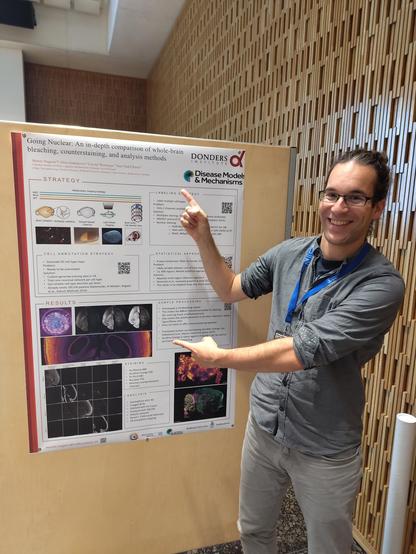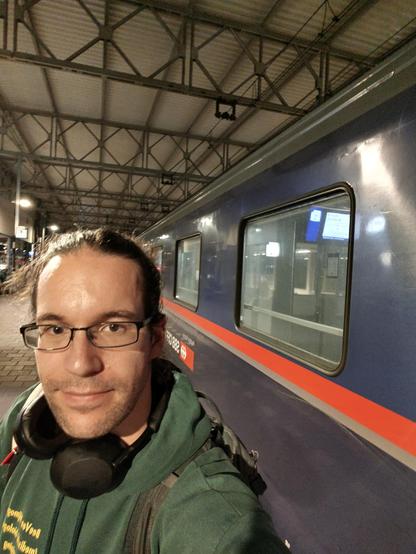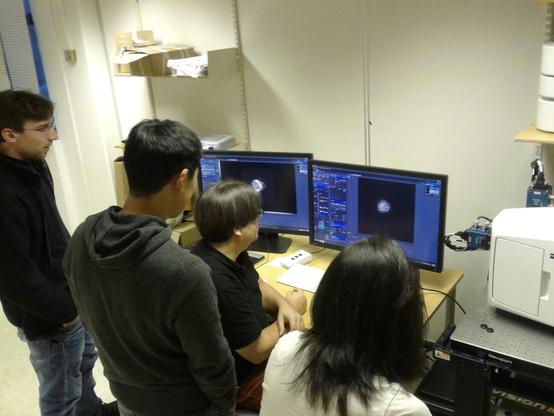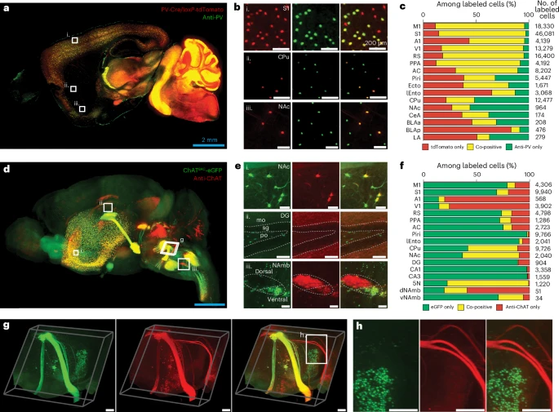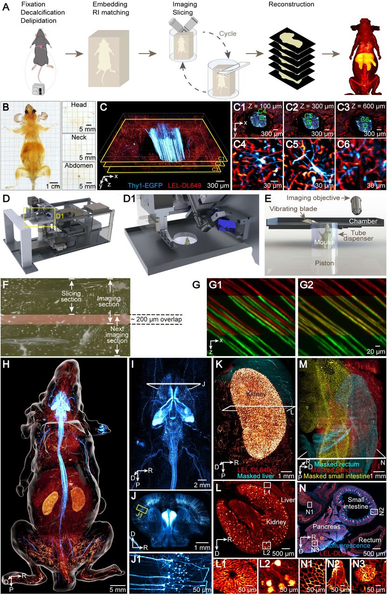This week I had the pleasure of attending the #MesoSPIM Symposium in Zürich, Switzerland - and what an experience it's been! Top-notch presentations, great posters and great chats with my fellow #lightsheet #microscopy and #tissueclearing nerds. You know it's a good conference when you come back with a full notebook and a head fizzing with ideas on what to do next.
I could make the night train journey there thanks to @Co_Biologists's DMM Conference Travel Grant - much appreciated!
#lightsheet
Lightsheet microscopy demo
First day of Lightsheet Z.1 demo @Sars_Centre imaging live embryos of marine worms.
—
URL: https://brunovellutini.com/posts/lightsheet-microscopy-demo/
Last week to apply to the Light-Sheet Image Analysis Workshop.
A five-day practical course on the processing and analysis of light-sheet microscopy imaging data. It will take place in Santiago, Chile, from January 5–9, 2026.
Deadline: August 8.
Learn more and apply here: https://lightsheetchile.cl/light-sheet-image-analysis-workshop-2026-2/
#Microscopy #Lightsheet #ImageProcessing #ImageAnalysis #LatinAmerica #GlobalSouth
Ceratitis open peer review
I reviewed a paper last year about the embryonic development of Ceratitis capitata, the Mediterranean fruit fly (or medfly).
The authors used time-lapse recordings of whole embryos made with lightsheet microscopy to create a comprehensive staging system for the embryogenesis of the species.
Figure 1 from Strobl et al. (2024). doi:10.1371/journal.pone.0316391It was one of the first reviews that I signed (disclosed my identity) from the beginning—and it felt right. As much as I understand the advantages of anonymity against power abuse from influential people, signing a review brings accountability and connection among peers.
The authors opted to publish the peer review history along with the paper, so now everyone can read it.
References
Strobl, F., Schmitz, A., Schetelig, M. F. and Stelzer, E. H. K. (2024). A two-level staging system for the embryonic morphogenesis of the Mediterranean fruit fly (medfly) Ceratitis capitata. PLoS One 19, e0316391. https://doi.org/10.1371/journal.pone.0316391
Strobl, F., Schetelig, M. F. and Stelzer, E. H. K. (2022). In toto light sheet fluorescence microscopy live imaging datasets of Ceratitis capitata embryonic development. Sci. Data 9, 340. https://doi.org/10.1038/s41597-022-01443-x
—
URL: https://brunovellutini.com/posts/ceratitis-open-peer-review/
#ceratitisCapitata #diptera #embryo #evoDevo #lightsheet #microscopy #review
Light-Sheet Image Analysis Workshop 2026
The Light-Sheet Image Analysis Workshop is a five-day intensive course that will take place in Santiago, Chile, from January 5–9, 2026, designed for students and researchers who wish to gain foundational skills in the processing and analysis of light-sheet microscopy imaging data.
The application deadline has been extended until August 8, 2025! The workshop is free to attend and travel fellowships are available. Learn more and apply here:
https://lightsheetchile.cl/light-sheet-image-analysis-workshop-2026-2/
—
URL: https://brunovellutini.com/posts/light-sheet-image-analysis-workshop-2026/
Colormap for mitotic waves
In a recent email exchange, someone asked me what the colors in the video of mitotic waves mean and how did I get them.
How the microscope technique results in the array of colors in the cells (purple to yellow and red). Could you briefly explain where the colors come from and how you visualised them?
It’s a great question. The topic is fascinating, and I had a lot to say about it. Since my answer might be helpful to more people with similar questions, I turned it into a blog post.
Answer
The basic approach to obtaining these images is to shine lasers at the sample and capture the resulting glow (or fluorescence imaging). The laser excites the molecules, and some will emit light in response. If we do that with a regular fly embryo, we will not see much because it doesn’t naturally have any fluorescent molecules. So, if we want to study processes in the embryo, we need to create a transgenic fly that expresses fluorescent proteins.
This specific fly from the movie expresses two different fluorescent proteins. One is a green fluorescent protein (GFP) linked to a regular protein that is always together with DNA inside nuclei (histone). The other is a red fluorescent protein (mCherry) linked to another protein that is always bound to cell membranes (Gap43).
After we put the embryo on the microscope, we shine two different lasers at the sample, and the proteins will emit fluorescence in green (~510 nm) and red (~610 nm) of the light spectrum. Using filters in the microscope, we can capture the signal from each protein on two separate images (channels). Despite the original fluorescence being green and red, the data that the microscope records is grayscale. So at the end I have two separate images, one showing the signal from the proteins in the nuclei (Histone-GFP) and another showing the signal from the proteins in the membranes (Gap43-mCherry)—both in grayscale!
What we do, then, is to choose a color for each channel. This can be any color, red/green, purple/orange, yellow/blue, etc., and does not need to match the original fluorescence color. It basically depends on what the researcher wants to highlight in the image. Some color combinations work better than others, depending on the type of signal (tiny dots or large structures), and in the observer. For example, we humans are not good at seeing details in blue but see better in green.
For the membrane signal in the video, I selected a grayscale gradient (from black to white) because it is great and uniform for our eyes. If it is a single-color image, using grays is the standard. In this case, I wanted the membranes to be present but more in the background. They appear more prominently at the beginning of the video and then fade into the background at the end when the main signal is purple.
For the nuclei signal, the main subject of the video (where most action happens), I wanted something more colorful and chose a gradient named “mpl-inferno”. It is a colormap that goes from black-purple-magenta-red-orange-yellow (see it here), and it is great to highlight small differences in signal intensities. It also comes with several technical advantages, like being color-blind safe.
Colormap mpl-inferno. Source: https://bids.github.io/colormap/In the video, this colormap creates a captivating effect. As you noticed, the nuclei at the center of the image are bright yellow, and the color fades to orange and purple towards the edges of the embryo. This happens because the embryo is like a cylinder. Since its central portion is closer to the lens of the microscope, the camera can capture a brighter signal. In contrast, the nuclei at the edges of the embryo are further away from the lens, making the signal dimmer and more purple with this colormap.
My post, mitotic waves and gastrulation, has a few more details about the creation of the video if you want to take a look. I hope this is helpful. Please tell me if something wasn’t clear or if you have other questions.
—
URL: https://brunovellutini.com/posts/mitotic-waves-colormap/
New publication from Kwanghun Chung lab at MIT improves on their SWITCH approach and eFLASH stochastic electrotransport to improve antibody labeling by gradually shifting the microenvironment. Looks interesting, I wonder how well it can be adapted to other labeling protocols.
Uniform volumetric single-cell processing for organ-scale molecular phenotyping
Yun et al., Nature Biotechnology 2025
https://doi.org/10.1038/s41587-024-02533-4
#neuroscience #tissueclearing #lightsheet #microscopy #fluorescenceFriday
Whole-mouse imaging the hard way: Clearing, then slicing + block-face imaging with beam-scan / sensor scan-line synchronization and continuous stage movement in an oblique imaging setup (ViSOR).
This time, they scaled it up to whole-mouse and used pre-cleared mouse bodies (ARCHmap-blockface-ViSOR):
High-speed mapping of whole-mouse peripheral nerves at subcellular resolution
Shi et al., preprint at biorxiv 2025
https://doi.org/10.1101/2025.01.22.632569
New deep-learning cell detection pipeline for light-sheet mouse brain image stacks, with an interesting cell-coordinate clustering statistics approach:
A deep learning pipeline for three-dimensional brain-wide mapping of local neuronal ensembles in teravoxel light-sheet microscopy
Attarpour et al., Nature Methods 2025
https://doi.org/10.1038/s41592-024-02583-1
Code: https://github.com/AICONSlab/MIRACL
Documentation: https://miracl.readthedocs.io/
Cool custom-built #lightsheet #microscopes: Turns out you can build a tiny light-sheet projector by whipping an optical fiber back and forth in front of a GRIN lens. The entire assembly is hand-made (coils, magnet, casing) and fits into an 18G needle. This looks like it could be super useful for imaging deep in vivo, e.g. low in a cortex.
Light-sheet microscopy enabled by a miniaturized plane illuminator
Kim et al., Biomed Optics Express 2024
https://opg.optica.org/boe/fulltext.cfm?uri=boe-16-1-115&id=565214
Wow, TRISCO (née TRIC-DISCO) is out in Science! This cool approach allows imaging of mRNA transcripts throughout the cleared mouse brain. It uses a signal amplification step with in situ Hybridization Chain Reaction (isHCR) and combines it with DISCO-style solvent-based #tissueclearing to make the brain transparent.
Whole-brain spatial transcriptional analysis at cellular resolution
Kanatani et al., Science 2024
https://doi.org/10.1126/science.adn9947
In case anyone was following the recent Science paper about using Tartrazine for #tissueclearing, apparently there is at least one (competing) group that couldn't reproduce it and wrote a preprint about it:
Tartrazine cannot make live tissues transparent
https://doi.org/10.1101/2024.09.29.615648
Discussion on Pubpeer, including the Tartrazine paper's author's response:
https://pubpeer.com/publications/81314BB3706B3D6ADAD49F301B2FA5
New solvent-based #tissueclearing protocol claims reduced tissue distortion: Dehydration/delipidation with Hexanediol, tert-Butanol and N-butyldiethanolamine, and clearing with Benzyl Benzoate / PEGMA / N-butyldiethanolamine.
SOLID: minimizing tissue distortion for brain-wide profiling of diverse architectures
Zhu et al., Nature Comms 2024
https://doi.org/10.1038/s41467-024-52560-7
Mitotic Waves video wins Small World in Motion
My video of mitotic waves won Nikon’s 2024 Small World in Motion video competition! I’m thrilled 🎉
https://www.youtube.com/watch?v=KhKlUu1SdZI
To learn more about the video, check out Nikon’s press release and their article for the series Masters of Microscopy.
There’s also a blog post that I wrote a couple of years ago with some biological information and technical details about how I created the video.
If you are wondering about the size of the embryo and how fast it really develops, there’s a version with a scale bar and time label on YouTube and available for download and re-use on Wikimedia Commons.
Thanks for your support :)
—
URL: https://brunovellutini.com/posts/mitotic-small-world/
#diptera #drosophilaMelanogaster #embryo #lightsheet #microscopy #scienceOutreach #video
New #tissueclearing #preprint uses a custom mouse behaviour + deep-learning c-Fos analysis pipeline to compare several different Serotonin receptor agonists / antagonists in mice.
Concerted modulation of spontaneous behavior and time-integrated whole-brain neuronal activity by serotonin receptors
Friedmann et al., preprint at biorxiv 2024
https://doi.org/10.1101/2024.08.02.606282
#lightsheet #microscopy #serotonin #neuroscience #preprint #brainmapping
New #tissueclearing paper checks oligodendrocyte distribution throughout the entire mouse brain. Looks pretty neat!
Brain-wide mapping of oligodendrocyte organization and oligodendrogenesis across the murine lifespan
Xu et al., preprint at biorxiv 2024
https://doi.org/10.1101/2024.09.06.611254
Github: https://github.com/yxu233/Xu_Bergles_brainwide_oligo_map
#neuroscience #lightsheet #microscopy #preprint #oligodendrocyte #myelination
For #TBT, we’re looking back on the interviews with CZI grantees by Constadina Arvanitis & Mariana De Niz. This week we’re highlighting Alenka Lovy, whose CZI project aims to connect labs by implementing light sheet microscopy at a larger scale.
https://focalplane.biologists.com/2024/01/24/enhancing-global-access-interview-to-czi-grantee-alenka-lovy/
#microscopy #lightsheet #microscope #interview
This preprint looks like a conceptual advance for deeper staining (also in human tissue) and multi-round multiplexed immunostaining with BABB clearing.
INSIHGT: Accessible multimodal systems biology with quantitative molecular phenotyping in 3D
Yau et al., preprint at biorxiv 2024
https://doi.org/10.1101/2024.05.24.595771
#tissueclearing #lightsheet #microscopy #neuroscience #FluorescenceFriday
Landmarking via UV-activatable dye makes mapping between light-sheet and confocal imaging possible
Correlative multiscale 3D imaging of mouse primary and metastatic tumors by sequential light sheet and confocal fluorescence microscopy
Zheng et al., preprint at biorxiv 2024
https://doi.org/10.1101/2024.05.14.594162
Interesting new #preprint about #tissueclearing and #lightsheet #microscopy in mouse ovaries. Complete with #napari-based deep-learning pipeline and detailed build instructions for 3D-printed sample chambers for solvent-cleared samples, so they can be viewed under a #confocal!
OoCount: A machine-learning based approach to mouse ovarian follicle counting and classification
Folts et al., preprint at biorxiv 2024
https://www.biorxiv.org/content/10.1101/2024.05.13.593993v1
